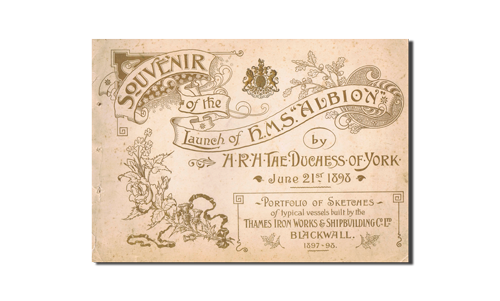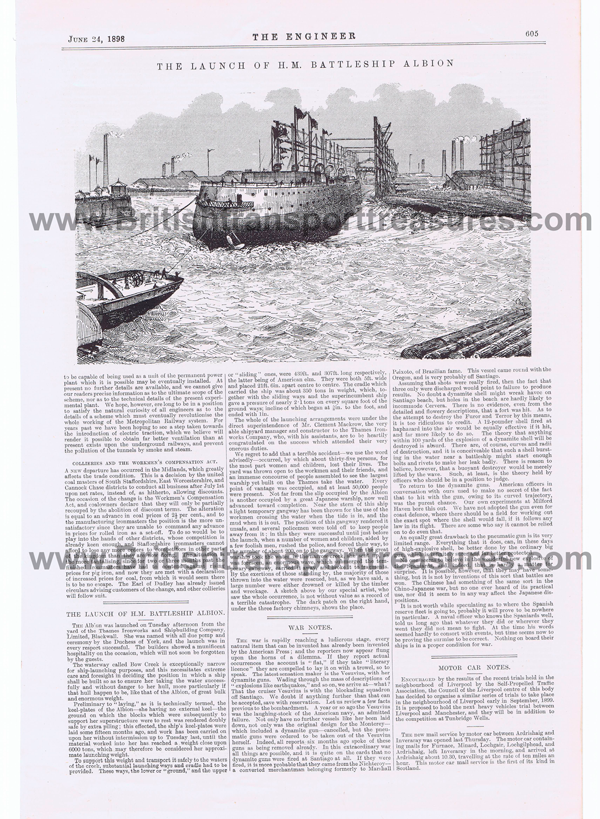Description
Portfolio thin card covers, originally ribbon bound 13”x 9.5” containing 12 stunning chromo-lithographs by W.S. Tomkin, printed by Waterlow and Sons, London Wall, London on good quality thick paper, depicting vessels produced by the yard in the previous 18 months. Each is interleaved with a sheet of thick semi- transparent tissue paper with printed details of the vessel or vessels illustrated. The images are 9”x 5.75” within a decorative border and have been scanned at a high resolution so that they can be downloaded to produce quality prints. If your printer does not produce good quality photographic work you are advised to take the images on a memory stick to a professional print shop.
The subjects range from a striking portrayal of Destroyer HMS “Zebra” speeding to the attack at night, through British and foreign Battleships (including of course “Albion”) and other naval vessels. Civilian craft are represented by a steam-launch for the British Ambassador to Constantinople, above and below Bridge Thames river steamers and a rowing life boat for the NLBI as it was in those days.
HMS “Albion” a “Canopus” class pre-Dreadnought Battleship, was laid down by Thames Iron Works at Leamouth, London on 3 December 1896. Tragedy struck when she was launched on 21 June 1898; after the Duchess of York (later to be Queen Mary) christened her, a wave created by “Albion ’s entry into the water caused a stage from which 200 people were watching to collapse into a side creek, and 34 people, mostly women and children, drowned. “Albion ’s” completion was delayed by late delivery of her machinery. She finally began trials late in 1900, during which she was further delayed by machinery and gun defects, and she was not finally completed until June 1901. Not perhaps a lucky ship?
A sunny June day, flags and bunting flying, a band playing, VIP guests, including ladies in their summer finery, the launch of Britannia’s latest Battleship the largest ever built on the Thames – and Royalty! The yard was normally closed to the public on launch days but the Company made an exception and East Enders turned out in their thousands. Obviously stewarding of such a large crowd was inadequate. Despite the much smaller death toll the East End was plunged into mourning as deep as that following the Princess Alice disaster some years previously.
For obvious reasons, this seems to be a pretty scarce publication. From being a colourful reminder of an important and happy event it had become a symbol of a terrible tragedy. I imagine many of those who had copies threw them out. Arnold Hills, the Thames Ironworks Boss, a compassionate man would very likely have had any remaining copies destroyed.
Two pages from THE ENGINEER, 24 June 1898. There can be no doubt that THE ENGINEER was wrong-footed by the tragedy which occurred only three days before publication, two days before leaving the print works to go to the distributors. As a monthly periodical in the days of letterpress large sections of the magazine would already have been printed awaiting collation with the remainder when printed. The description of the ship and her proposed engines would have already been set in type with space left for a couple of lines of “local colour” from “our man at the launch”. To make room for even the briefest mention of the tragedy, the description of the engines had to be separated from the description of the ship, two complete pages had to be re-plated, moving items around to fill in gaps, making for a very messy layout. One can only blame the pressure under which this was carried out for the appalling gaffe of congratulating the yard manager for a successful launch in one sentence and in the next, without even a sub-headline, go on to say that over 30 people were drowned…
PREVIEW BELOW – MAY TAKE A WHILE TO LOAD.


Reviews
There are no reviews yet.